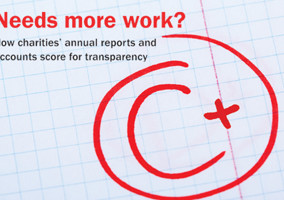The Charity Commission’s online register of charities was viewed 8.1 million times in 2015/16. That’s a lot of people looking at your charity’s details, and by extension, your annual report and accounts.
It may be questionable how many donors are taking the time to review these (often lengthy) documents, but funders, public officials and journalists all take a keen interest. Ensuring that these stakeholders hold a positive view of your charity is important for your future success.
So are charities doing a good enough job with their annual reports? Certainly, many of the larger charities are making an effort. It is evident in these cases that communications teams have been heavily involved, liberally introducing colour, images and infographics, as well as helping to ensure text is clear and well written.
But, as our cover this month suggests, could these charities do better? It is certainly easier said than done, but Helena Wilkinson (pages 16-21) makes a good case that it’s time for a fundamental rethink.
For me, there are two issues. Firstly, many annual reports consist of an exhaustive list of achievements which will test the patience of all but the most committed supporters. Could charities get their message across more effectively in less words?
And secondly, there is an issue of balance. While the desire to treat the annual report as a marketing tool is understandable, does an exclusive focus on positive achievements merely serve to undermine trust? Could acknowledgement of challenges and things that didn’t work out as anticipated give reassurance that the charity is asking tough questions about how it operates, and crucially, be more interesting for the reader?
Wilkinson rightly highlights Marie Curie as an exemplar of good practice. Its report lays out the charity’s strategic objectives and reports honestly on performance against each of last year’s targets.
Yet most other charities have not reached this level. Indeed, of the 25 charities in the top 100 which reported under SORP 2015, 17 did not even deliver on the new requirement to measure successful delivery of their strategy.
Clearly there is more thinking to be done.
Community accountancy in decline
As for smaller charities, the challenge remains principally one of compliance. Martin Gibson (pages 22-23) reveals drastic failures to comply with the SORP among charities with income below £500,000.
Nearly half of the accounts he looked at did not meet more than half of his 13 indicators of compliance. Gibson found that in many cases the problem is professional accountants not having the required knowledge of charity accounting. Community accountancy services are a better option, but as the chief executive of Community Accounting Plus recently warned, such services have “died a death” in London. Some other regions are similarly lacking.
It’s hard to see an easy solution to this – if the funding isn’t there, and small charities don’t feel able to pay for community accountancy services themselves, then there isn’t a valid business model.
But with transparency and accountability high on the agenda these days, charities need more help than ever with their annual accounts, and funders should give serious thought to whether they can step in.
Related articles









